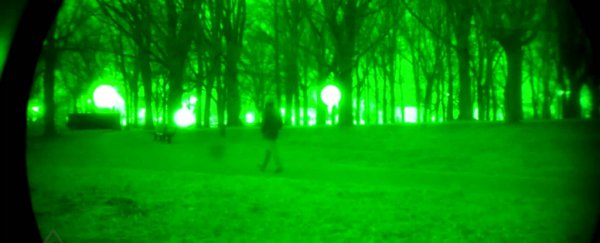For the first time, scientists in Australia have created a light-bending nano crystal that's 500 times smaller than a human hair, and it could be used to create the future of ultra-light night vision glasses.
Instead of the cumbersome night vision goggles we current use, the new crystal could one day convert a pair of regular glasses into night vision glasses. In other words, it could make reverse sunglasses.
"The nano crystals are so small, they could be fitted as an ultra-thin film to normal eye glasses to enable night vision," said lead researcher Dragomir Neshev from the Australian National University.
What they've made is a tiny crystal that can 'tune' the light passing through it - and not just by tinting or polarising it on one level. This is what polarised sunglasses do now, by bending light so it travels just on one plane - sunlight is usually messy, so this cuts glare and makes your vision clearer in bright light.
But the new structure is capable of actually changing the light in three crucial ways: the intensity of light, the shape of light, and even the colour of light. All of that together means that it can take very low levels of light, such as at night time or in dark areas, and tune them to be visible.
Before you get too excited, we're a long way off using this in our glasses. So far, the team has only managed to make one of these crystals - to see in the dark they'll need to make an entire array of them that tune the light in a very specific way.
But what's exciting is that they're the first to make one of these crystals small enough that it can fabricated right onto regular glass, which makes it a lot more versatile than other light-bending materials.
"Our eyes … see objects only in the visible spectrum," explains one of the team, Mohsen Rahmani, in the video below.
"If we can fabricate an array of other nanostructures on flat surfaces like glass, at the end of the day we will be able to convert invisible light [into] visible light."
In addition to helping build the next-generation of night-vision glasses, the crystal could be used to twist light in all kinds of useful ways.
For example, those holograms on bank notes that prove they're not counterfeit could be created from these light-bending crystals. And they could also produce powerful new holograms.
"This tiny device could have other exciting uses including in anti-counterfeit devices in bank notes, imaging cells for medical applications and holograms," said Neshev.
The team has now been able to fabricate a form of the crystal 500 times smaller than a human hair directly onto glass.
In the latest study, they've also shown that it can convert invisible light to visible light on the small-scale, and have done all the mathematical calculations to show how this is happening. There's a lot more work to be done, but it's a promising first step.
"This is the first time anyone has been able to achieve this feat, because growing a nano semi-conductor on a transparent material is very difficult," said PhD student and team member Maria del Rocio Camacho-Morales.
We can't wait to see what they do with these crystals next, because incognito night-vision glasses sounds like the best future Christmas present ever.
The research has been published in Nano Letters and is being presented to the Australian Institute of Physics Congress in Brisbane this week.
